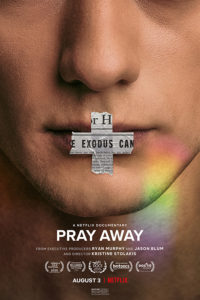Review: Pray Away Documentary

The documentary Pray Away (now streaming on Netflix) demonstrates the immense power of religious belief and its ability to destroy people’s lives. It follows survivors of conversion therapy and leaders from Exodus International, an organization created to forcefully persuade individuals to denounce their same-sex attractions and conform to a heteronormative life.
The film profiles several individuals—including leaders of Exodus—who believed all they needed to do was “pray away the gay.” It highlights the painful journey to overcome “behavioral desires” and the “psychological illness” of homosexuality. It emphasizes how leaders of the ex-gay movement internalized the idea that being gay was pathological and tells of a sincere and profound belief in scripture that says transformation is possible and being gay is not God’s intention. They thought some weakness within them made them gay, which Bible study, behavioral modification, and peer counseling could change. God could save them from this “sin”. Adherents were convinced that helping people change was the absolute right thing to do. The film shows how each participant struggled with shame, humiliation, guilt, isolation, and dishonesty, searching for belonging and self-acceptance. And how almost all of them realized they were wrong.
Pray Away (from executive producers Ryan Murphy and Jason Blum, and director Kristine Stolakis) exposes Christian ministries for perpetuating the enduring harm of homophobic and transphobic ideas of conversion or “reparative” therapy. It addresses the various tactics Christian ministries used and still use to try to change sexual orientation and gender identity. It also highlights how the psychological and religious industries mutually benefited from working together to convert individuals. Each capitalized on the premise that gay people are “broken” because of their attractions, but one can squelch these desires, so people don’t “act out” on homosexuality. It was a business arrangement to legitimize the Christian ministry’s religious message while providing clientele and notoriety to the therapists.
In the film, speakers from Exodus tell crowds of individuals that childhood trauma causes gayness. Indicating that if one can resolve those childhood issues, then there is no need to be gay. Leaders exploited and groomed younger converts to tell their personal stories publicly as a way to push their narrative. The film highlights an Exodus founder who talks about the annual conference as the most significant event where individuals could gather to support the anti-gay movement. The conference’s workshops focused on embracing traditional masculinity or femininity, as antidotes to being gay. Conference attendees also took part in gender-conforming activities, such as the men playing football and the girls wearing make-up, as conditioning towards becoming what “God wants” you to be. Finally, the film illustrates the direct pain caused to individuals—from denial of attraction to self-inflicted harm to suicide.
The film ends with a powerful group therapy session that resulted in the admission from ex-gay leaders that Exodus caused death and serious harm. Multiple leaders admitted that they could not excuse or deny that what they were doing was wrong. They finally agreed that conversion therapy was a lie, and the Exodus community dealing with faith and homosexuality did nothing more than hurt people. These leaders finally shut down the organization after over three decades of damage.
I found the documentary horrifying from both a religious and therapeutic standpoint. The film astonished me with the extent of how many people were desperately seeking help. Moreover, it was eye-opening that a small ministry support group flourished into Exodus and a national campaign to change people, all based on religious ideals and unfounded psychological theories. I found it incomprehensible that individuals with no formal therapeutic education, training, or specific qualifications utilized religious dogma and pseudo-psychology in an attempt to mold and conform others. It was criminal.
However, I was impressed and moved by the no-longer-ex-gay leaders coming forward to tell their stories. It takes a lot to move away from solid convictions and a community you thought was there to help. Even more, it’s brave to admit wrongdoing and to end an organization that they helped build. These former leaders acknowledge that apologies are not enough to make up for the damage they caused, but they continue to speak out against the harmful practice as imperative to stop it for good. Ultimately, they tell us that the only antidote to these kinds of groups is working to end homophobia, knowing that as long as homophobia and transphobia exist, there will be some version of conversion therapy.
It saddens me that despite this documentary and the ongoing efforts of those who have left the ex-gay movement, conversion therapy continues today.
